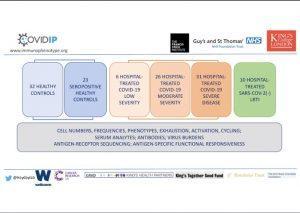Professor Adrian Hayday shares an overview of a completed deep immunophenotyping of 100 COVID-19 patients and controls (figure below), in the 13th IUIS webinar.
Highlights of the webinar include
- Discovery of an immune cell signature based on cell phenotypes that distinguished COVID-19 treated patients from SARS-CoV-2 seronegative and seropositive controls. However, this signature did not correlate with SARS-CoV-2 viral burden.
- As observed by others, Prof. Hayday also detected higher levels of in SARS-CoV-2 specific-antibodies, inflammatory (IL-6, IL-8) & anti-inflammatory (IL-10) cytokines, and activated T cells in COVID-19 patients compared to controls. They also detected higher levels of IP-10 (CXCL10) in COVID-19 patients compared to controls and patients with other lower respiratory tract infections.
- Description an overt T cytopenia (decrease in Th1 & Th17 cells but not Tregs nor Th2 phenotypes), T cell activation (CD38+HLA-DR+) and exhaustion (PD-1+Tim-3+) in severe COVID-19 patients compared to controls.
- Prof Hayday concluded his talk suggesting that some of these features e.g IP-10 could have prognostic value. As well as highlighting that COVID-19 disease pathology blends pathologies observed in other diseases e.g. acute respiratory distress, vasculopathy, as well as immune responses kinetics observed in other diseases such as sepsis, among other pathologies.












